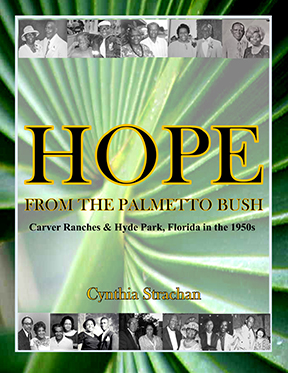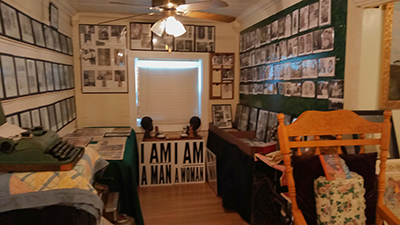By Nunnie Robinson
Part III
“The history of Carver Ranches is a silent voice that speaks of the hardship, hope, challenge and unity from a people of courage and faith. They dared to settle a new and unknown land, thereby earning the title of “ Pioneers.” Cynthia Strachan-Saunders from her book, Promises from the Palmetto Bush
 After the Carver Ranches devas, featuring Stephanie Bevel, Gussie Clark, Audrey Warren and Cynthia Strachan-Saunders answered my question about their passion for Carver Ranches, the area’s inception became the focal point. Three white men – H.E. Foster, Donald F. Anderson and Carl Hoffman – businessmen, one of whom was an attorney, formed a corporation, purchased, developed, and sold the land specifically to Blacks, many of Bahamian descent who settled first in this 300 acres, undeveloped section of western Broward replete with Palmetto bushes and unimaginable critters like snakes, raccoons, possums, gophers, rabbits and polecats among others. It is believed that many unscrupulous white men through pillory or price gouging, or as Mr. Foster explained to Mr. and Mrs. Strachan : Whites would buy up a lot of property and charge astronomical prices for rent, thus taking full advantage of vulnerable tenants because they could. Mr. Foster and the other gentlemen wanted to change that pervasive practice.
After the Carver Ranches devas, featuring Stephanie Bevel, Gussie Clark, Audrey Warren and Cynthia Strachan-Saunders answered my question about their passion for Carver Ranches, the area’s inception became the focal point. Three white men – H.E. Foster, Donald F. Anderson and Carl Hoffman – businessmen, one of whom was an attorney, formed a corporation, purchased, developed, and sold the land specifically to Blacks, many of Bahamian descent who settled first in this 300 acres, undeveloped section of western Broward replete with Palmetto bushes and unimaginable critters like snakes, raccoons, possums, gophers, rabbits and polecats among others. It is believed that many unscrupulous white men through pillory or price gouging, or as Mr. Foster explained to Mr. and Mrs. Strachan : Whites would buy up a lot of property and charge astronomical prices for rent, thus taking full advantage of vulnerable tenants because they could. Mr. Foster and the other gentlemen wanted to change that pervasive practice.
 The Strachans were one of the first families to purchase a home in Carver Ranches at a cost of $750, $75 down and & $50 a month. It might seem reasonable but in the early 40s that was a daunting proposition. Then other families followed such as Walter and Easter Robinson, and Ethelyn Bowles, Cynthia’s grandmother. In just my initial reading of Promises from the Palmetto Bush, certain principles became crystal clear: Carver Ranches epitomized the village concept/community where people and families assisted each other with projects such as childcare, installing inside toilets, encouraging educational pursuits, and wives/mothers using their God-given gifts to help each other. The story was told of a lady who needed a roof for her house. Once she secured the supplies, the men joined forces and put a new roof on in short order. And while they were working together, you best believe she and friends were preparing food for them to simply express their gratitude. I’m certain that scenario repeated itself many times over. Forced or not, it was that spirit of community that propelled Carver Ranches’ growth and maturation as a thriving entity.
The Strachans were one of the first families to purchase a home in Carver Ranches at a cost of $750, $75 down and & $50 a month. It might seem reasonable but in the early 40s that was a daunting proposition. Then other families followed such as Walter and Easter Robinson, and Ethelyn Bowles, Cynthia’s grandmother. In just my initial reading of Promises from the Palmetto Bush, certain principles became crystal clear: Carver Ranches epitomized the village concept/community where people and families assisted each other with projects such as childcare, installing inside toilets, encouraging educational pursuits, and wives/mothers using their God-given gifts to help each other. The story was told of a lady who needed a roof for her house. Once she secured the supplies, the men joined forces and put a new roof on in short order. And while they were working together, you best believe she and friends were preparing food for them to simply express their gratitude. I’m certain that scenario repeated itself many times over. Forced or not, it was that spirit of community that propelled Carver Ranches’ growth and maturation as a thriving entity.
Cynthia explained that the original office building on Pembroke Road used to transact business such as selecting a lot or making payments is still there, though it has been renovated. In determining the area’s rapid growth and development, all agreed that it was via the church, social clubs, and word of mouth, the cell phone of the day, that accelerated growth. Once a family was settled, another would be motivated to take the risk. And that was the non-secret secret. Stephanie said those pioneers worked and saved their money until they were able to purchase a home or lot, that there was much pride in those pioneers which attributed to Carver Ranches’ rich heritage. Gussie stated with great emphasis that her parents paid $250 for the lot that her home sits on today, a source of pride for the many pioneers who took similar action.
 The same house was built by her father, a plumber who was always in demand, and men in the neighborhood, a form of bartering. They would work on Saturday and return to Miami until the family could move in. Men worked as carpenters, plumbers, farmers, custodians and some even as small business owners like the beer garden known as Kokomo Joe’s. One truism was that the banks did not benefit financially from Carver Ranches pioneers because they saved their money and purchased homes and lots independently. Cynthia said that she couldn’t remember a male whose education went beyond elementary school. However, they were smart, skilled, industrious, and selfless. Cynthia remembers one gentleman, a construction worker, who would bring one concrete block home daily from work to assist in building a home for someone else or a family member.
The same house was built by her father, a plumber who was always in demand, and men in the neighborhood, a form of bartering. They would work on Saturday and return to Miami until the family could move in. Men worked as carpenters, plumbers, farmers, custodians and some even as small business owners like the beer garden known as Kokomo Joe’s. One truism was that the banks did not benefit financially from Carver Ranches pioneers because they saved their money and purchased homes and lots independently. Cynthia said that she couldn’t remember a male whose education went beyond elementary school. However, they were smart, skilled, industrious, and selfless. Cynthia remembers one gentleman, a construction worker, who would bring one concrete block home daily from work to assist in building a home for someone else or a family member.
The discussion then focused on areas of Carver Ranches that emanated in the 50s at the end of the war.
New developments sprang into being like Olgis which is now Adventura and Hyde Park where similarly designed homes were constructed for Black veterans. The first Black general contractor, Mr. Ceaborn Bohler, was instrumental in Hyde Park’s development. He was a brilliant man as were others, just not as well known. Like many Black communities across America, segregation compelled self-sufficiency, generating a plethora of small businesses such as funeral homes, restaurants and hotels and personal enterprise, increasing the vibrancy and sustainability of communities like Carver Ranches. People also used their God-given gifts as singers, musicians, seamstresses, crocheting, et. al. to promote and increase the quality of life while inspiring the youth.
The preservation of our history is occurring all over South Florida because of people like the late Mrs. Enid Pinckney whose parents were first pastors of the Church of God of Prophecy, the Hampton House and the Curtis Foundation in Miami just as Cynthia is the catalyst behind the preservation of Carver Ranches’ rich heritage.
Near the conclusion of our discussion, circumstances begged the question: How do you feel about integration? The general consensus was that although our leaders’ intent may have been honorable and well intended, the repercussions and consequences, especially involving our youth, loss of businesses, self-reliance, unity and singleness of purpose have created an enormous vacuum which may take generations to recapture. So we must continue to trust in God, support local community historians and preservationists and bring our communities together because we truly are stronger together.

